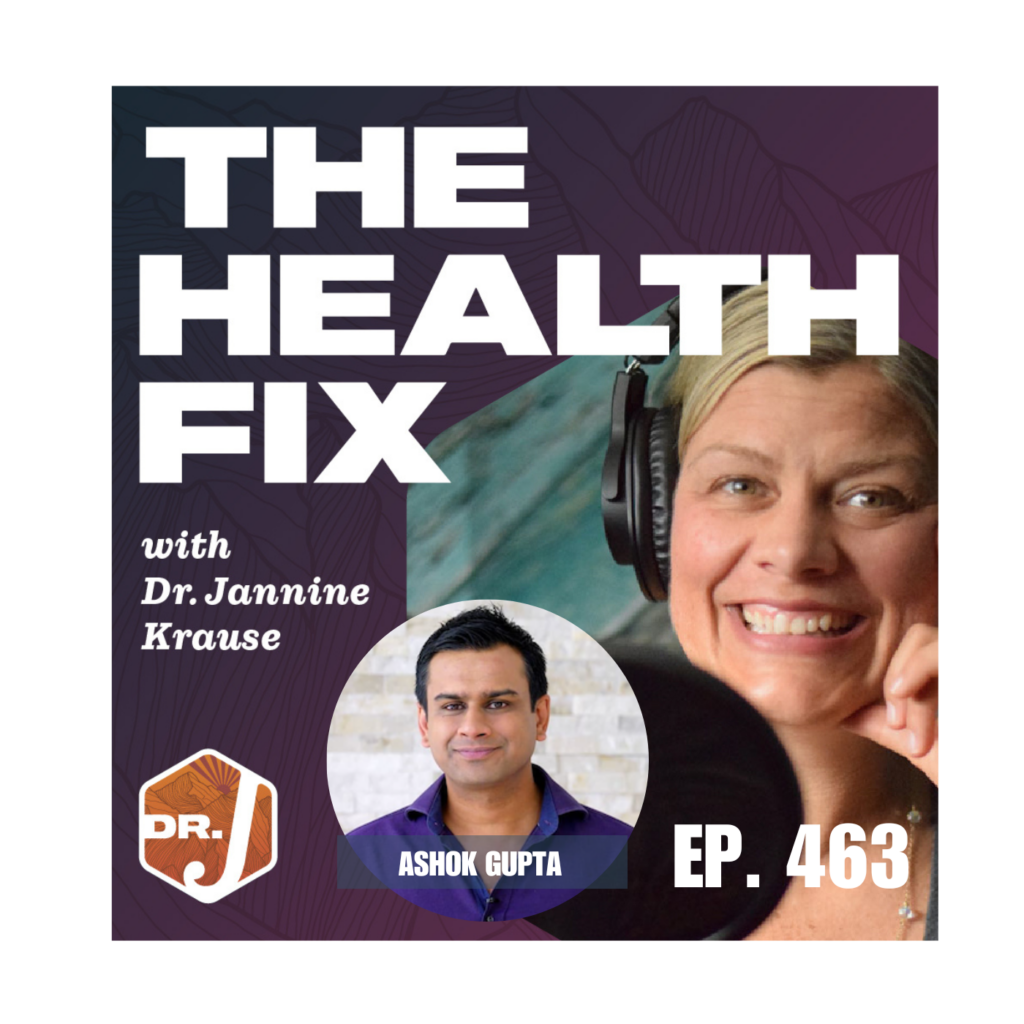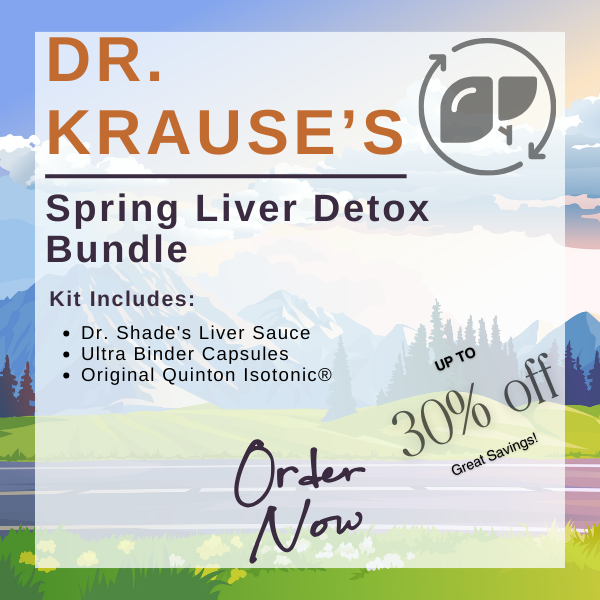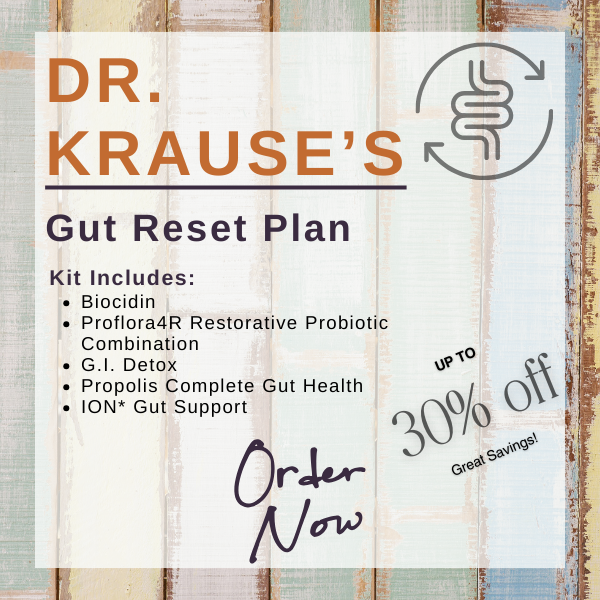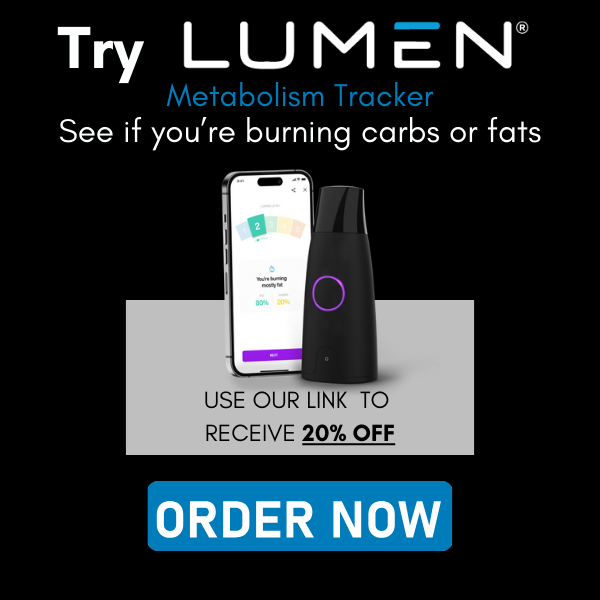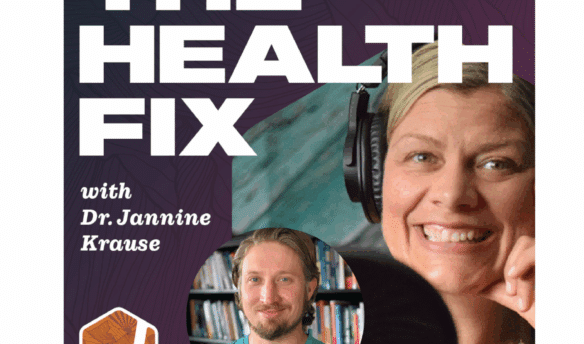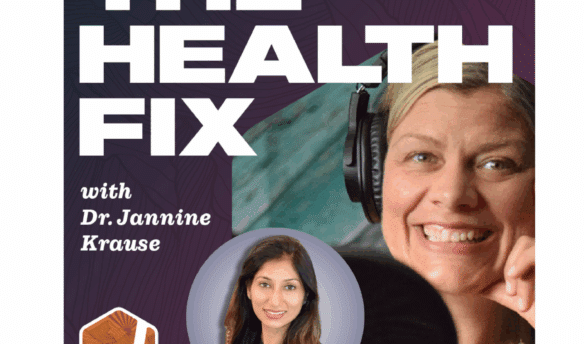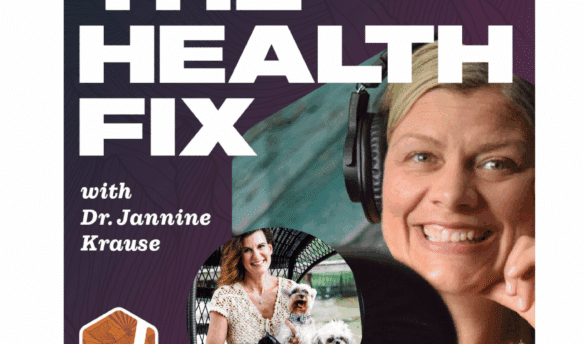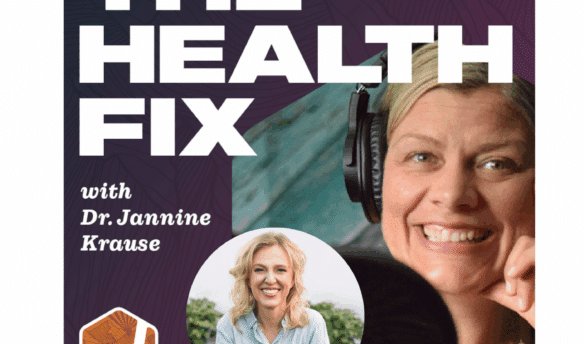Curious about why some people can handle stress and illnesses and recover quickly while others struggle? Have you been sick and feel like you never recovered from the illness? Perhaps your body feels ok but your brain function hasn’t fully been restored? Ashok Gupta suffered from Chronic Fatigue Syndrome (CFS-ME) 30 years ago while at Cambridge University. Through his own neurological research, he was able to recover 100%. Since 2007 he’s been teaching others on neuroplasticity and “limbic retraining” using his Gupta Program. In this episode of The Health Fix podcast Dr. Jannine Krause interviews Ashok Gupta on how the immune and nervous system interact to keep you chronically sick unless you retrain your brain’s response to immune stress triggers.
Dr. Krause’s Protocols
Instructions Included
Traveling soon? Looking to detox or reset your gut? Try one of Dr. Krause’s Fullscript plans.
What You’ll Learn In This Episode:
- How your brain’s primal goal of survival causes chronic illness
- Why pain, mold, allergens, microbes are considered “not safe” to your nervous system
- The immune system feedback loops keeping you sick
- How a hyperdefensive brain causes you to get sick with lesser triggers each time
- Utilizing brain retraining to recover from chronic illness and ensure the body it’s safe

Resources From The Show:
Our Partners
Podcast Transcript
3:28 – How the Gupta program came to be
8:00 – How a gut bug can cause the brain to go off the rails
9:50 – 40% of human DNA is the same as a banana
19:!8 – How the amygdala and insula work
26:36 – Brain retraining
28:20 – Can worrying about eating organic food and environmental problems cause a danger response in the brain?
31:42 – Background low grade inflammation
32:09 – The recipe for bad health
33:53 – About the Gupta Program
37:56 – Ashok’s daily process
40:13 – Success stories – 82 years young
43:13 – Where to find Ashok’s programs and scientific results
Hey, Health Fix junkies, it’s Dr. Anna Marie from the Happy Whole You Podcast.
It’s a podcast where I talk about all things brain health, mindset, and holistic wellness.
Check out episode 454 on The Health Fix Podcast where I talk about how to transform your biology
by changing how you think.
You’re listening to the Health Fix Podcast with your host, Dr. Jannine Krause.
Hey, health junkies. On this episode of the Health Fix Podcast, I’m interviewing Ashok Gupta.
He suffered from chronic fatigue syndrome 30 years ago while at Cambridge University.
And through his own neurological research, he was able to recover 100%.
Since 2007, he’s been teaching others on neuroplasticity and limbic training in his
program called the Gupta program.
Today we’re going to be talking about his theory when it comes to chronic fatigue, fibromyalgia,
mold toxicity, multiple chemical sensitivities, and more.
Here’s the thing.
His theory is exactly what I’ve suspected over the years.
So when I saw his information, I was like,
okay, yes, you have to be on the podcast.
So many of the hard to treat chronic illnesses
are triggered by a long period of stress.
Then something infecting or agitating the immune system
starts to create a cycle.
where the immune system keeps fighting,
telling the nervous system, there’s still danger.
And now, eventually, any exposure to a bug,
allergen, toxin, and boom,
the cycle of illness repeats or flares up.
If this sounds like you,
or you know someone dealing with this type of situation,
please share this podcast with them
because this information is so important.
It can save you time, money, grief from multiple protocols
that don’t work.
I can tell you that in my own personal experience.
So let’s introduce you to Ashok Gupta and his Gupta program.
Hey, health junkies.
I have the Ashok Gupta on with me today.
And we’re going to be talking about something
that I love to talk about because brain retraining
and really trying to understand what is going on
with chronic illness when no one else can figure it out
is definitely my jam and definitely something
I want folks to have access to.
So we’re gonna talk about the Gupta program.
We’re gonna talk about what Ashok’s up to
with his crew and all of that today.
So Ashok, welcome to The Health Fix Podcast.
ASHOK: Thank you, Jannine.
Thank you for the invitation and it’s lovely to be here.
JANNINE: Well, I’ve been excited about this podcast
because I’m always on the hunt for helping folks
to overcome conditions when it seems
had nothing else was working, we can’t find answers. And in
looking through your, your process, I thought, gosh, you know, a
lot of this makes sense. And a lot of it really kind of hits,
hits home for me in terms of how I see a lot of chronic illness
presenting and folks. So before we go there, though, you have
your own story of being chronically fatigued, you know,
just just not doing so well, 25 years ago or so. So I would
love to hear kind of how it presented for you and what you did to kind of get to the point to create
the Gupta program and then we’ll talk all about what it’s all about.
ASHOK: Thank you Janine, yes.
So like many of us you’ve come into this field it’s often been as a result of our
own challenges, our own health challenges that we faced. So I remember gosh this was
almost 30 years ago now, almost 30 years ago I was studying as an undergraduate Cambridge
in the mid 90s and I got some kind of bug, some stomach bug, felt flu-y and the stomach
bug kind of went away but it left a legacy where suddenly I felt worse and worse and worse physically.
So it was when the worst moments were I had to crawl to the bathroom. I couldn’t read words on a
page. I was exhausted all the time. It slept 12 hours a night but just felt exhausted and I
I thought there must be something seriously wrong here.
So I go from doctor to doctor and they would say,
look, we don’t know what causes this.
We don’t know what to call it.
We don’t know what we really have.
We don’t have any treatments for it
and you might have it for the rest of your life.
Goodbye, there’s nothing we can do.
And you can imagine for a young man
that was like almost like a death sentence.
So there’s nothing we can do about this illness.
And I met so many other hundreds of people
who were suffering from this.
And you know, in my worst moments,
I just made this contract with the universe.
I said, if I can just get myself well,
I will dedicate the rest of my life
to helping others with this condition
because there is untold suffering out there of millions,
if not tens of millions of people
who have these unknown diseases.
And their quality of life, they say,
is that the equivalent to the latter stages of cancer
in terms of how it affects them.
And yet no one seems to be really focusing the research.
And so I then read brain neurology, physiology,
and I came across some really interesting work
by someone called Professor Joseph Ladou,
who was one of the foremost neuroscientists in the mid 90s.
And I formulated a hypothesis
as to what might be causing this in my brain.
And I essentially retrained my brain in a very hot, hot way,
’cause in the mid 90s, I mean, these diseases
weren’t recognized at all often.
And I managed to get myself 100% well,
and then I published a medical hypothesis,
which was published online in ’99 and then in a journal in 2002,
and then went on to set up a clinic to treat others.
And then obviously we’d have the app
and all the medical studies that we’ve done.
So it’s been a real journey over the last 25 years.
And like many of us on this journey,
at the time it felt absolutely awful,
but I realized for me, it was a blessing
because it completely changed who I was,
who I choose to become,
and the work that I’m now able to do.
So yeah, it’s been a real journey.
JANNINE: Oh my goodness.
I can imagine, right?
Having been a doc almost 20 years now,
I’ve seen a lot of folks walk this walk
and have been frustrated for them,
looking at different things.
And really, it’s heartbreaking
because you see people spending so much money
trying medication after medication,
protocol after protocol, and supplements like crazy,
of course, because I’m a naturopath,
That’s kind of, you know, where a lot of people come to me
and in that department and really, you know,
what you have as your article here,
looking at the brain and looking at the immune system.
So kind of the neuro-immune logical response, if you will,
is something that I’ve kind of come down to.
And I think folks are starting to become aware
because COVID long haul kind of got the conventional
medicine world to realize that viruses can cause long-term
symptoms like the, the, um, oh my gosh, brain is going, of course, right now, the, the things
like the long haul of even mono and things of that nature as a whole. But, but what I see
a lot in my practice, maybe because it’s in the Pacific Northwest and it’s a little more damp
is the mold and the mold coming up and over again. Um, and any little exposure pops off more.
And that was the one thing that, that really your video caught me was like,
yeah, you know, we have this initial exposure kind of like your gut.
And then things pop off from there.
So explain if folks who are listening a little bit of how you were thinking, like,
okay, I’ve got this gut bug, then my nerve, my, my immune system reacted to this
gut bug and then my nervous system reacted as well.
So give us a scoop of how that, how a bug could cause the brain to go off the rails.
ASHOK: Yeah, it’s a fascination, isn’t it?
Like, this is the curiosity,
there’s a geek side of me that says,
“Well, I want to understand this.
“What on earth is going on?”
And it is a mystery.
We’ve got different jigsaw pieces,
but we don’t know how they fit together.
And in the mid 90s, I just had to tell you
about a leap of faith to say,
“Okay, let’s arrange the jigsaw pieces like this.”
And this could be a way,
this could be a picture that we could build up.
And I know exactly what you’re saying
’cause I meet naturopath, nutritionist, you know,
every day, in fact, who are recommending our program
in conjunction with the work they’re doing.
And they say to me, you know, it’s so frustrating
because we do some great work with clients
and we get them a certain stage.
But as soon as they have a stress in their lives
or an infection or something,
wham, all the symptoms come back
and we continue with the same protocols,
but it doesn’t seem to change.
So then we have to introduce a new protocol
and don’t get me wrong, sometimes people do go on to heal
and they have their lives back and that’s great,
but sometimes they don’t.
And it’s such a mystery to understand what’s going on.
So if I can paint a picture of this whole hypothesis
as to what I believe causes these conditions.
So the starting point for all of this is,
for me, it has to make logical sense scientifically
as to why these diseases come.
So we asked the first question of all,
the ultimate question of fact, why are we here?
Now, I’d love to have a philosophical discussion
with Jannine about this,
but let’s focus on the science for the moment.
So we’re here because over millions of years of evolution,
this nervous system, this immune system,
has evolved over millions of years,
tens of millions of years, in fact.
So from, you know, plant life, single cell organisms,
invertebrates, vertebrates, reptiles, mammals, human beings,
we have evolved along that charter.
And many people don’t realize that we actually contain
the DNA of all those previous animals.
So our DNA contains 40% of the same DNA as a banana,
which I find really fascinating.
So we really literally are at one with nature
because we’ve come along the evolutionary trail
to get to where we are.
And so therefore, the number one priority of the brain
and our nervous system and our immune system
is to survive, adapt to our environment
to ensure survival, procreate,
and pass on our genes to the next generation.
So that’s our first jigsaw piece in this puzzle.
That the brain doesn’t care whether you’re well,
whether you’re reacting to mold
or anything like that.
What it cares about is, are you surviving?
That’s the number one priority.
That gives us a little clue to these different conditions.
And then what happens is,
let’s take the example of COVID
because we all know somebody who’s got long COVID,
who’s still suffering the after effects of that, right?
So imagine COVID comes along and our nervous system
and our immune system are on standby mode
and then suddenly incomes,
what we call in medical terms, an insult.
So we get this virus coming in.
And normally our immune system and nervous system
is activated, the nervous system being the electrical system
of our brain and our nervous system through our body.
It’s almost like the information system
that tells the body what to do.
And then we have our immune system,
which is obviously, as we know,
the part that protects our body from these invaders.
And imagine that normally we fight it off.
We fight off the virus and our body comes back to standby.
But imagine for whatever reason, the brain decides
that after we fought off the COVID infection,
it errs on the side of caution to say,
I’m not sure if we fought off that virus completely.
Maybe it’s still around.
And this is equivalent to how war veterans become
traumatized in a state of war.
Even though they come back to civilian life,
they still react as if the war is on to the slightest trigger.
And a way to kind of describe this is,
Let’s take, I don’t know if you’re a Game of Thrones fan
by any chance Jannine.
(laughs) If not–
JANNINE: I’m not, but I’ve heard enough about it,
so I can follow.
ASHOK: Heard enough about it.
So let’s take the example of a fairy tale.
So let’s imagine Janine that you are Queen Jannine,
well that has a rhythmic ring to it.
Queen Jannine of your kingdom.
And imagine that your kingdom is essentially your body.
And you are the prefrontal cortex,
so you’re the rational conscious mind
that is the master of this body, this kingdom.
And your army is your nervous system,
and your navy is your immune system
that defends this kingdom and this castle
against invaders, rival armies.
Now normally an army comes over the hill,
army and navy fight it off,
your immune system and nervous system,
your system comes back to balance.
But imagine you’ve had a drought in the kingdom.
So now the kingdom is weaker,
the army and navy are weaker than they normally are.
And Jeanine, I don’t know if you noticed this
in your practice, but we certainly noticed
that people who are more prone to getting these conditions,
like ME/CFS, fibromyalgia, mold,
they tend to have some increased stresses
in the one year to six months in the run up
to getting the conditioning event.
So in this case, that’s the idea of the drought
in the kingdom.
It’s a little weaker than normal.
So now the virus comes over the hill
and the army and navy are galvanized, they fight it off.
But they take longer to fight it off
because they’re in a weakened state.
And we know from the field of psychoneuroimmunology
that our immune system is weaker when we’re more stressed.
And people think, “Ashok, are you saying
it’s emotional stress?”
And I say, “No, it’s not just emotional stress.
It can be physical stress.
It can be biological stress
if you’ve had a whole run of infections
or had an operation or something.”
Any kind of physical emotional stress
that comes into your body, mental stress,
can impact on its ability to handle another virus.
And so now what happens,
the generals come to their weekly meeting with Queen Jannine
and they say, “Queen Jannine, we’re not sure
if the rival army is fully defeated.
They might be hiding in the forests.
So we need all the resources now of the kingdom.
So we need the metal, the wheat, the corn, the water supply.
Forget the population of the kingdom, we need that.
‘Cause if we don’t survive defending this kingdom,
The whole kingdom will fall and everyone will die.
So you think, as the queen, that makes logical sense.
Okay, you get the resources.
So now the army and navy keep fighting off their weapons
of war, keep firing it off to the invaders
who might be hiding in the jungle.
But what happens is, some of those arrows
fall back into the kingdom accidentally.
That’s where we get the inflammatory effects
in the body, the inflammation of the body.
We get the weakening of the gut.
we get the auto-immune effects.
So some of those arrows falling back in,
that’s the triggering of the immune system.
And not only that, then the spies in the kingdom,
who normally the secret service look after
and get rid of the spies, they start proliferating.
So now you’ve got opportunistic viruses,
opportunistic infections that start proliferating
in the kingdom, sensitivities, et cetera, et cetera.
And this system, the weaker and weaker the kingdom gets,
the army and navy generals keep coming to you each week
saying we need more resources, we need more resources, we need to defend the kingdom.
And the way this works in your immune conditions like long COVID, fibromyalgia, ME, chronic
fatigue syndrome is that the weaker and weaker that the kingdom becomes and the more and
more arrows falling to the kingdom, the more and more the army and navy keep firing off
their weapons of war at the slightest provocation. And the symptoms themselves, the physical
symptoms in the body, become the trigger to the brain that we might still be in danger,
the immune system, a nervous system causing the symptoms in the body which will loop back to a
hypersensitive brain round and around we go. And that’s when we go from an acute phase of
condition to an chronic disease state. Because logically there must be a feedback loop which
is keeping someone in a state of illness. And in the case of let’s say pain syndromes, similar thing,
the pain networks of the system become hypersensitized. So even though there’s no external
thing causing the pain anymore. Our pain networks get sensitized, our anxiety networks get sensitized,
and now those pain signals keep coming into the brain even though there’s no obvious logical reason
for the pain, but that then means that we send more inflammation to that part of the body with
the pain which causes the pain and so on and so on. And finally the mold that you talked about,
this is very interesting. So we treat not only more deorness but chemical sensitivities,
electrical sensitivities and many other food sensitivities and allergies. And what we notice is
that in this scenario the army were absolutely right to defend the kingdom. So when there was a
mold exposure at some point in someone’s life, when they were really stressed, the army and navy
reacted to that mold exposure. And that may have been a semi-threatening level of exposure.
But once the system is conditioned, that means it’s learned to react, then,
let’s say the first time was 100% exposure, now 5% exposure is enough to trigger the defensive
response. And therefore, someone might go into a house that they never reacted to before, but suddenly
now they’re reacting to the mold, even though their other family members are not reacting,
because their brain has learned to hyper-defend them. And then you can see the whole system,
it gets into a state of chronic illness and you can certainly have a nutrient, you can have
supplements, you can have changes in diet and they can impact and suddenly they may persuade
the system that we’re safe and the army may maybe go back to normal but another provocation
comes along, guess what they over respond or react and brain retraining is that next meeting
that you have with your army generals you say to them my dear generals you have done a wonderful
job in protecting the body, but the war is over. Stand down. We are no longer under threat.
And then what happens is the army and navy, if they can be persuaded, and that’s the
purpose of neuroplasticity as a repetition, if they can be persuaded that we are no longer
in danger, no longer in the same position as we were when the illness first came along,
then they will stand down and the body comes back to homeostasis. And that’s what we do
doing brain retraining is persuade the system to do that from neuroplasticity.
So in a nutshell, that is the hypothesis.
Yeah.
JANNINE: It makes perfect sense to me.
It’s like the body has PTSD from the virus, the mold, the chemical, the whatever it may
be.
And it just goes on hyper alert.
And I see this all the time, kind of like you would describe, the army kicks itself up
again, each time there’s some threats.
And so, as a doc being frustrated,
because here I am trying to, okay, now what do we do?
How do we change the protocol?
How do we mop up the mold toxins?
How do we, whatever it may be, how do we get the virus out?
And obviously, I’ve learned that over killing viruses
and things of that nature doesn’t work.
We need to go back to the brain and the inflammation response.
So tell us a little bit about the amygdala, the insula,
like the actual brain workings here.
So folks can kind of get an idea of like,
okay, what is actually happening deep in the brain?
And how are you using neuroplasticity
to work on those specific areas?
What are you guys doing in the group,
to probably around like,
what would people be doing as their biofeedback trainings?
ASHOK: Sure.
So often people think that when we talk about the amygdala
insula that these brain structures
are operating in isolation.
But of course, the brain is this massive interconnected
network of different structures
that are constantly communicating with each other.
And not only that, they’re constantly communicating
through the body.
That’s why with the vagus nerve,
so the vagus nerve is one of the primary communication points
for upward and downward information flows.
And we hear a lot about the vagus nerve recently.
And so the brain structures that are involved include the amygdala, the insula, but also
then the prefrontal cortex.
We talked about the rational mind, you, your subjective experience of being you is kind
of stored up here.
And then we talk about the anterior cingulate.
So so many different brain structures are involved.
The amygdala and insula, if we talk about those two for a moment, the amygdala, there’s two round
almond shaped structures that sit behind the eyes.
And their role is to take in incoming data, incoming sensory data and judge it as to whether
it’s threat worthy or emotion worthy.
And remember our emotions are essentially reactions to our environment to help us keep
safe.
So even anger or fear or guilt, they’re all emotions that keep us safe.
And so the brain is constantly monitoring that and the emotions are often processed within
the amygdala in our unconscious, that’s these unconscious fear receptors. And those brain
structures, that’s where we believe that some of the nervous system conditioning is stored
and that has been shown in some animal studies. And that’s where we believe the nervous system
starts learning to over respond. And when we talk about PTSD, anxiety, conditions, they’re
often located or have been certainly shown to be primarily located in the amygdala.
Secondly, the insula part of the brain. Now this is a different structure. It sits between
the limbic system and the cortex. And there have been other programs out there and other
processes that have started calling this limbic retraining whereas actually that’s inaccurate
because the insular doesn’t sit in the limbic part of the brain. It actually sits, it’s actually
the core part of the cortex. And that part of the brain is designed to take in all incoming data
from our body, whether it’s immune data, nervous system data, physiological data, heart rate,
process it, decide whether we’re on the threat and create the appropriate immune and nervous
system response. And this you’re going to find really fascinating to you. So some research
that was conducted many years ago, because we always hypothesized it was the insular.
Some research showed that actually when they gave rats sweet water combined with an immunosuppressant,
those rats immune systems got suppressed, which is what we would expect. They repeated that
processed five times. And what they found was they could give those rats sweet water without the
immunosuppressant and guess what happened? The rats immune system was suppressed. So that’s what
we call neurological learning in the brain. That’s neuroplasticity where the brain is making a
connection saying well when we have this immunosuppressant combined with sweet water, maybe it’s the
sweet water that’s giving us the instruction to ratchet down the immune system. And when they
they dissect the brains they find that it’s stored primarily in the insular part of the brain
and supported by the amygdala. And this is something we hypothesized 15 years ago and it’s now modern
research is showing that this is true. And some recent research by Dr. Asya Rose in Israel,
and this is absolutely fascinating. They took rats and they created inflammatory bowel disease
in these rats by giving them an agitator in their gut. Yep, that inflamed the bowel and they measured
the electrical signature in the brain, specifically in the insular. Then they bought these rats back
to baseline and they triggered that same electrical signature in the brain, just in the insular part
of the brain. And guess what? They were able to create inflammatory bowel disease in exactly the
same way just by triggering that one part of the brain. And it’s the first time in modern science
that we’ve learned that peripheral immune responses, so things that happen in our bodies,
that information flows back to our brain and gets stored centrally in our insula
ready for the next response, which then makes sense that if we’ve responded to a virus, a bacteria,
mold, electrical circuits, our system learns that response in the insular ready for the next
time that it occurs because the brain’s efficient, it wants to help us survive. So it thinks, well,
if that was a threat the first time and we only just overcame that threat, then we must respond
five fold, 10 fold, every time that threat,
even a small amount of that threat comes forward.
And that’s when we get in neurological conditioning.
The brain is now conditioned to over respond
to even small levels of that threat.
And we believe this explanation also works
for allergies and food sensitivities.
At one point in time, let’s say,
I’m trying to think a good example,
we get food poisoning from something, right?
And it’s from a specific type of food.
So the brain learns, look, this food makes me ill,
it’s dangerous.
So then the gut learns that sensitivity.
So the next time you have that food,
it has a massive response because it’s trying to warn you
that this food is dangerous.
But of course, that food wasn’t dangerous.
It was just the situation.
And also, wheat and dairy,
which are the two most common sensitivities,
they’re just things, foods which are generally,
the population is sensitive too,
’cause they’re hard to digest.
And therefore, most people, when they get these types
of illnesses will go on to having these kind of
wheat and dairy type allergies, egg type allergies.
And so that makes sense as well.
So I believe that the hypothesis also applies
to those conditions as well.
[Advertisement] Hey, health junkies.
Wanted to tell you about my pal Dr. Annamarie Frank’s
supplement line that specifically targets the needs
of women from anxiety to depression,
to getting focused and balancing those hormones,
as well as helping with sleep she’s got you covered.
Plus she has T’s too.
This day and age, it’s hard to know what supplement companies are up to when it comes
to sourcing and quality.
That’s why I love to get to know company owners.
Dr. Annamarie has created formulas that combine what I would do if I owned a supplement and
tea company.
So, wanted to tell you about them.
As a listener of the Health Fix Podcast, you can get 10% off your order by using the
code DRJKRAUSE when you head to happywholeyou.com.
Now say you’re driving or out on an adventure and you’re not going to remember where to find
this website.
That’s okay.
My favorite products are all on my website at doctorjkrausend.com.
Just click on shop and you’ll find everything I stand behind and use myself right there.
So let’s get back to the podcast.
ASHOK: So in terms of how the Good for Program works, it is essentially a home study course.
It’s an app.
go through the videos, the audios, and there’s weekly webinars with myself where we teach
patients how to recognize these unconscious signals.
It’s very close.
It’s very different to CBT or any kind of cognitive work.
This is brain retraining.
More equivalent to, let’s say, when you’re rehabilitating after a stroke and you need to
create new neuronal connections with parts of your body.
In a similar way, we’re training the brain that we are no longer in danger and it can
ratchet down these responses. Something that’s been a game changer, and I’m sure
Janine, you see this in your clinic, is what we call daily goop to size. So these
are daily zoom calls that our clients come on to, which have the nervous system
regulation and the brain retraining. And that has been a game changer because
many patients are isolated. They feel slightly anxious or depressed. They don’t
know how they’re going to feel each day. But knowing you can come on to a zoom
call and we take care of you and take you through all the exercises means it just is
ratcheting up people’s recoveries which has been fantastic. So yeah that’s been a great
support. So yeah it’s a home study course weekly webinars and we have 20 to 30 trained
coaches around the world where people can have one-on-one sessions as well.
JANNINE: Yeah and multiple languages I hear is what you have too.
Yeah that’s right so we’ve been translated into Spanish, German, Finnish and we are going
to be looking at French is coming soon and Italian is coming soon as well.
JANNINE: Cool.
Cool.
So I have a question for you.
Just just something that came to mind and something I, you know, hypothesize in my
head because let’s face it, a lot of us have a lot of information that comes in
about organic food, eating clean, you know, environmental toxins.
Do you think that at some point that even your worry about all of those things
creates a little bit of what I’m going to call a PTSD, you know, danger response within the brain.
Do you think that have you seen that connection because I know when a lot of people start to get
want to improve their health, they start to get really worried about, oh my gosh, I didn’t
eat something organic or what about, you know, my environmental exposures, my EMF exposures.
Do you feel like that has an impact and can also create issues?
It’s such an interesting question and a very complex answer to a simple question, which is that
imagine the brain, the body, our whole system is like a bucket and it can handle a certain amount
of stress and that stress is physical, mental, emotional and dare I say it’s spiritual.
In turn the amount of stress we can handle. So if we are eating lots of inorganic food with lots
of toxins in it. That’s a certain amount of stress that comes in the bucket but our system can
can just about handle it. But then if we’re pouring a lot of emotional stress in them,
a lot of worry in there, a lot of infections that we’re suddenly exposed to. Whatever it is,
the more and more we put in there, eventually the water starts hitting the limit at the top
of the bucket and starts flowing over and that’s when we get illness, when our system can no longer
have the capacity to handle the amount of stress that’s coming in. There’s a special word for it,
It skips me now, but that is where, yes, if we worry too much about our food and our environment,
that’s just an added stress into the system that can make things worse. Having said that,
it doesn’t mean that those things aren’t true either. So it’s a both and answer to that.
So yes, we should look at eating as cleaner diet as possible and taking the right supplements.
But if people become obsessive by that, especially food exclusion, you’re just putting so much more
stress it. And I’ll give you an example. I find it so funny, right? So some of my clients
will be like, “Oh gosh, yes, I’m feeling worse there because I didn’t have my chia seeds,
so I didn’t get my omegas and I didn’t get this and now I’m feeling worse.” And I say
to them, “You know, look at the stress you’re taking your system through. Oh, you had a
slight tiny, tiny bit of bread. Oh, now your system’s reacting.” All the stress and anxiety
is triggering your nervous system to make it more likely that your gut is going to go
into dysbiosis and can’t handle all these different foods.
But also, I know people who eat junk food,
they smoke, they drink, and they’ve got bags of energy,
right, and they don’t have any cut issues or generally.
And you think, how is that possible?
What is the difference there?
And it comes down to that sensitivity in our nervous system.
And we make it more sensitive the more that we worry
and obsess about these types of things.
And I give you another example, like I know,
if I’m working hard in my clinic, I’ve got a busy clinic,
clinic, I’m seeing lots of people and I’m running everything, I have to be careful with my diet,
I have to make sure I exercise and meditate and eat good diet and healthy things and not sugar.
But the moment I go on holiday and relax, I can pretty much eat what I want without any other
effects, right? Now what is going on there? Once again, it’s the idea of the bucket, your capacity,
to handle that level of stress and so that’s what we want to improve on. Now there is something
that’s tangential to your question which is I do believe that because we’re living in a more
toxic environment in terms of our food and pollution our systems are undergoing what we call a
background low-grade inflammation so we’re constantly in this danger threat response
because we’re living in a more dangerous environment so that’s putting stuff in the bucket but more
importantly well just as importantly our modern way of living we are literally breeding people to
to have anxiety and depression because what we’re doing is taking people from essentially
agrarian communities or fishing communities, hunter gathering communities. The last 100
years ago, put them in a box, make them stare at a screen for 12 to feel 14 hours a day,
make them sedentary, get them low exposure to daylight and sunlight, make them eat toxic
foods, have no exercise and put them under a huge amount of stress and finally get them
to compare themselves to everybody on the planet through social media.
Literally a recipe for bad health.
And so that’s why we’re seeing more and more of these diseases because our system, our bucket
is overstressed.
We’re overthreatening the system and then infections and stuff come along and they’re
the straw that broke the camel’s back and then we launch into illness and the system
then goes into this hyper-defensive state.
So therefore our patients, they know that we want them to get well,
we want them to stay well.
So we then once we got them well, 89% recovery, we then work on their stress,
their parts work, they’re, you know,
I coach them on that to make sure they have a more stress free life.
Moving on from that.
JANNINE: Oh boy. Yeah.
There’s a lot to impact there and what you just said because it is,
it is how I feel too.
I feel like we, we have taken people and created,
created illness just by, by the lifestyle.
– Now, I have a question.
I think a lot of people might be thinking right now,
like, okay, how long does the program,
how long do people on average take
to kind of start re-training and feeling better?
Give us a scoop there.
ASHOK: So our program is a six month program.
And people might think, wow, six months,
that’s a long commitment.
But we can say three to six months,
but really that’s because we don’t want people
to become complacent.
So some people use our program
and within weeks and months, they’re getting better.
getting up to 80-90% recovery.
For others, it takes longer to see impact.
Because if your brain has been responding in a certain way
for months, if not years,
I mean, we’ve all seen clients have had it
for more than a decade, a couple of decades,
the brain isn’t going to get the message the first time
to say, hey, we’re safe and everything’s rosy, switch off.
It’s gonna take that repetition and time
and re-aclimatization to a new way of being.
So our patients, and that’s actually where the word
patient comes from, yeah, because in the olden days,
there weren’t any treatments, so it was just about
being patient.
And so therefore with this program as well,
we encourage people to commit to 100%,
but let go of the outcome.
Because once again, like our bucket,
if we keep saying, right, is it working yet?
Is it working yet?
Like if you have a scar on your hand,
you cut yourself and you have a scar,
if every day you keep picking at the scar,
then are you healed yet?
Are you healed yet?
We make things worse.
So instead, it is about going into our program,
using it every day, and then just trusting in the process.
That is the number one thing.
And of course, we’re used to a consumer society
where it’s why I take a pill
and I should be feeling better now.
That is the way we think.
And not only that, we think about health in that way as well,
but a commitment to do something every day
seems like a chore, but really it’s an investment in our health
because not only do we recover our physical health,
but we feel emotionally better
when we do these types of exercises.
So people commit to each day to these exercises,
come to the webinars, come to our daily events,
but the minimum investment’s just half an hour a day.
And I think that’s doable for most of us
and then little short exercises throughout the day.
We have people working full time who can do,
you still use our programme.
And through that commitment,
then over a number of months,
people feel the improvements.
But people know once they get the improvement,
they want to continue with our programme
because they know if they stop using it for a week,
Guess what?
Some symptoms come back sometimes.
Because the brain is still sensitive.
Like once you’ve trained the brain, it feels safe,
but it can still have that sensitivity.
So if a stress comes along, a virus comes along,
it may think it’s under threat again
and go back into its old responses.
So in some ways, living the good to lifestyle
is something that we do for the rest of our lives
to keep ourselves on top of how our body is responding.
And this relates, and,
I’m sure you see this in your clinic. This relates to what we call adverse childhood experiences.
So many people who get these types of conditions, there’s a predetermination, not predetermination,
but a predisposing factor which is childhood trauma, childhood bullying or abuse, that can be a risk
factor. So our amygdala’s have a factory setting and that is set by how our mother felt when we were
in the womb, how stressed she was, then the birth experiences itself and then the first
five years of life. First five to ten years, they impact on the factory setting of our
amygdala. Then what happens during later life that determines our levels of sensitivity
to the world around us. Not only our emotional sensitivity, but actually our physiological
sensitivity, which is why people who’ve had a background of trauma, they’re more prone
to then getting these neurological events in the brain, which cause them to over-respond
to viruses, bacteria, mold.
And that in a nutshell is a simple reason
why people three to four times more likely
to have these conditions.
JANNINE: Makes sense, it makes sense.
So I think a lot of people might be thinking now,
like, Ashok, okay, so obviously living the Gupta program
life, living the life, what do you do now
“to keep things at bay?
“What are you up to to kind of,
what’s your maintenance, I guess, protocol for yourself?
I’m just curious and I’m sure other folks might be too.”
ASHOK: Of course, yeah, and this isn’t the maintenance protocol for my clients because we know that
people when they’ve got stressed out nervous system, they wouldn’t be able to do this to
this level.
So this isn’t what I would recommend people doing, but now that I’m completely healed,
I wake up in the morning, have a big glass of water, often with alkaline water, so I’ll
put lemon overnight or cucumber overnight.
Then I will do some cardio.
So I’ll do 20 to 30 minutes of cardio exercise outdoors.
outdoors, I’m getting the bright light and I’m doing strength training and cardio. Then
I’ll have a shower and straight after that I will do yoga. Then I will do breathing techniques.
I do the breathing techniques from an organization called the Art of Living Foundation. I don’t
know if you heard of that, but they’re the Art of Living Foundation. Their breathing is
the topmost breathing I’ve come across and I really recommend that. Then I do 20 to 30 minutes of
meditation. So the whole process is about an hour and a half in the morning. But I know once I’ve
done that in the morning. My capacity increases. My bucket gets bigger and I can feel pressure
during the day. I can have lots of meetings but I’ll be absolutely fine because my system
and my nervous system has been refined to be calm, scented and relaxed. My capacity
has increased. And then I’ll meditate again in the evening before dinner and then before
sleep, I’ll go for a walk to allow my digestion to be better. I’ll sleep a good
for a walk after dinner and then before sleep might do some relaxation as well.
So that’s my kind of daily process.
JANNINE: I love to ask people that because it’s
fun to just hear and honestly most of the most chill people I know have this
you know a very similar kind of routine and so I think you know for a lot of
folks work kind of also all searching out like, okay, where can we get ourselves back to calm and safety? And obviously, that’s what you’re doing with your program, which is really cool.
And I’m just curious, because you’ve got the six months of seeing folks.
Are there any cases that stand out for you that you’re like, whoa, that was really cool? Could you share one with us just to kind of give folks like bring it off full circle so folks could hear kind of a cool case just inspired.
ASHOK: Oh, there’s so many, but the one that inspires me the most was there was a guy in New Zealand.
And that’s the great thing about having an app is we can reach everyone in the world.
He was in his early 80s, 82.
And this is a number of years ago.
And imagine when you’re 82 years old, I mean, you don’t know what’s causing what, right?
And when you’re at that age.
And he had fibromyalgia, mold, pain, you name it, he’d had it for 30 years.
And had a low quality of life, was very depressed.
And he used our program and over the space of six months he got gradually better and he got up to 80-85% healed.
And I said to him, “What are you going to do now?”
“You know, this is great, but you’re in your early 80s now.”
He said, “Hey, I’m going to travel the world.
I’m going to do all the things that I’ve always wanted to do in my life, but never had the opportunity to do it.”
And that inspired me because, you know, we might think, you know, by the time we’re in our 80s,
we, our brain’s not neuroplastic anymore, we can’t learn new things.
And yet that’s the great promise of neuroplasticity,
that even your 80s, you can learn a musical instrument,
you can learn to dance,
and your brain can learn a new way of responding.
And that, I think, if he can do it,
that anybody on the planet can retrain their brain,
or rewire their brain, and get their health back.
And that’s what really inspires me each day,
what gets me up every morning,
seeing the amazing stories and transformations
that people go through.
And then recently, long COVID,
And the long COVID stories are so fascinating
because we’ll get some people,
it will take months and months and months to heal.
And some people within 10 days, two weeks they’ll heal
because it’s not been around for so long, right?
It hasn’t embedded itself so deeply in the brain.
So we had a gentleman that, you know,
he was a marathon runner.
He cycled, could cycle 100 kilometers in a day.
And he suddenly was struck down with long COVID for a year.
He was on the couch.
And he managed to retrain and he got his health back.
And then he was back to marathon running again
and cycling and I just thought, wow,
it’s not amazing that you can just be flat on your back.
But just through the power of this brain retraining,
you can get your system back to balance
and then go on to that physical ability to come back.
I think the contrast was phenomenal.
Then we’ve had people within the end
and said one or two weeks
you’ve been able to get the health back.
But we don’t put that expectation in people’s minds
because the moment you have that, you’ll do this and think,
hey, why isn’t it working?
We say, give it at least six months
to really see what your brain is ready for
and the improvements that you will see.
JANNINE: Yeah, I think that’s so important
with not giving those up expectations
’cause like you said before,
it’s the old case of the weight loss program, you know?
(laughs)
You’re like two days later,
why haven’t I lost 10 pounds?
What’s going on?
Why isn’t it happening?
It’s tough, it’s a tough thing.
Wow, good stuff here.
So let’s tell folks how to find you,
what, you know, where’s the best place
to link up with you and learn more?
And how can they sign up?
ASHOK: Sure.
And just something I wanted to add was that
we can hear about a lot of these different types
of treatments and programs and various things,
but what matters to us is the science.
Because anyone can say, oh yes, this is going to get you well.
But we really focus on the science.
So we’ve conducted many medical trials, which you can see on our website.
You can see the full papers and they’ve been run by independent organizations.
And a couple of examples.
So we conducted a randomized controlled trial on fibromyalgia.
And we found that after just eight weeks of our program, there was a 40% reduction in
fibromyalgia scores in the Gupta program, but zero in the control group.
And we also halved anxiety, halved depression, etc. and halved pain, just in eight weeks.
And then a long COVID study that we did a couple of years ago,
we compared our program to a wellness program
that included diet, supplements, et cetera.
And after three months, the Gupta program
was four times more effective at reducing fatigue
and exhaustion and twice as effective
at increasing levels of energy.
And that’s an independent study that’s been published.
And we’re doing further studies right now.
And a recent study we just published,
which wasn’t a randomized control trial,
but it was a clinical audit.
It found that after three months
using the GUPTA program. Across 14 different conditions, people improve their health from
between 60 to 120 percent. For instance, Lyme disease, there was 116 percent improvement
in health after three months. Long COVID, I think it was 84 percent improvement in health.
That was a study across, I think, about three to 400 patients. Once again, we’re seeing that
there’s all these different conditions maybe out there that there may be one underlying
hypothesis as to what causes them. So we really want people to know this is now
being more and more science-backed and we’re doing more and more scientific
studies. So if people want to find out more about this we encourage them to go
to our website which is guptaprogram.com that’s G-U-P-T-A and on there they can
sign up for the free trial they can read our medical papers you can watch there’s
over 400 testimonials on there on our success stories page you can watch lots
videos of people’s experiences. And then you can also just go to the app store or play store
and search ‘good to program’, ‘brain retraining’ and there you can also just download the app as
well. So there’s lots of resources, lots of free videos and then if people feel that this is something
that’s right for them then they can sign up for our full premium program which is a one-year
subscription. And until we get large scale phase three trials we offer a one-year money-back
guarantee on our treatment, which is unheard of. So you can use our treatment if it doesn’t work for
you. We can return it. There’s a small payment for postage of packing, but you can return it.
Get your money back and use that money somewhere else. So people have got nothing to lose by giving
this type of approach, you know, a go. And we now are just, especially with a daily Gupta
size. I mean, imagine people get that yearly subscription and every day Monday to Friday
they’re having these daily Zoom sessions, which, you know, is unheard of. And we would caution
people that there’s a lot of programs now where people have either used our program or they’ve
created something but it doesn’t have a science that’s backing it up and they’re pushing it as
a brain-retraining program, etc. But often we find that a lot of those programs have lost the
essence of the compassion behind it or they become like a bootcamp approach. And we were the original
program to come up with this and keep looking to improve. And so not all programs are the same.
you know, it really is important to research the right one for you.
JANNINE: That’s, that’s why it’s advice because I have heard from, you know,
I’ve had a couple of other folks on, on the podcast too.
And we’ve talked about different brainery training.
Yours hits on what I’ve always suspected as the,
the overactive nervous system combined with the, you know,
the neuro immune response.
And so it makes sense to me.
It’s much like what I have hypothesized for years and,
and it makes sense. So I’m excited for you guys to get some more of the research.
ASHOK: The Phase 3 trials. The largest scale trials. Well, it all comes down to funding. And as
you know, the way our systems are set up, if you have a pill and you’re part of a pharmaceutical
company, you can afford to fund this type of thing. And yet in the last 30 years, no pharmaceutical
companies come up with any consistent treatment for chronic fatigue or chronic fatigue syndrome.
therefore more money needs to be channeled into this approach. So we have a 501(c)(3)
compliant fund in the US where people can donate money and that money goes purely to
non-profit research and we need to raise about half a million dollars, actually up
to a million dollars to really fund all of these different trials because as you know
medical research is extremely expensive. So once we have that funding in place then
we can do those largest scale phase two and phase three trials. So yes if anyone
can support us in that, who knows who can fund this, and then please do let us
know because that is our overarching need right now to get this done. But I
would hope in the next few years, I mean my dream is in five to ten years time
you go to see your doctor for one of these types of conditions and the first
thing they prescribe you is brain retraining. Imagine that we could
capture all of these conditions super early and don’t get me wrong we’re not
dogmatic so we do believe it’s useful to combine that with approaches like
yourself where we look at the nutrients we look at. So we other aspects of the lifestyle,
etc. So it would be a combined approach. And if we get that prescribed upfront, then that would
just be amazing and we’d relieve so much suffering around the world.
JANNINE: Absolutely agree. It’s definitely
the way for what we would call true holistic type of approach for sure. Wow, Asha, good stuff. This is
This is definitely fascinating.
I want to make sure that folks really can see the your theory.
So I’m going to figure out how to get that on to the the podcast so that they
can see it all right in front of them, how everything links together.
Cause that was one of the things that I was fascinated by when I was looking at
your website.
So great stuff here.
Keep up the good work.
I appreciate it.
ASHOK: Thank you so much.
[Outro] Hey, health junkies
Thank you so much for listening to another episode of the Health Fix Podcast.
To help support my mission, to bring you tips, tricks, and tools to help you optimize your
health, I’d be grateful if you’d like, subscribe, and write me a review for the podcast.
And if you hear a product you’re interested in on the podcast, you can now go over to
my website to learn more.
That’s a doctor spelled out, J-K-R-A-U-S-E-N-D.com.
click on shop and you’ll find all the information on my favorite products that I stay behind
and use myself.
All affiliate income earned with your purchases goes directly to help support the production
of the podcast so I can keep bringing you quality health information.
I appreciate your support and I’m honored to have you listening to my podcast as a fellow
health junkie.
Thanks again.
